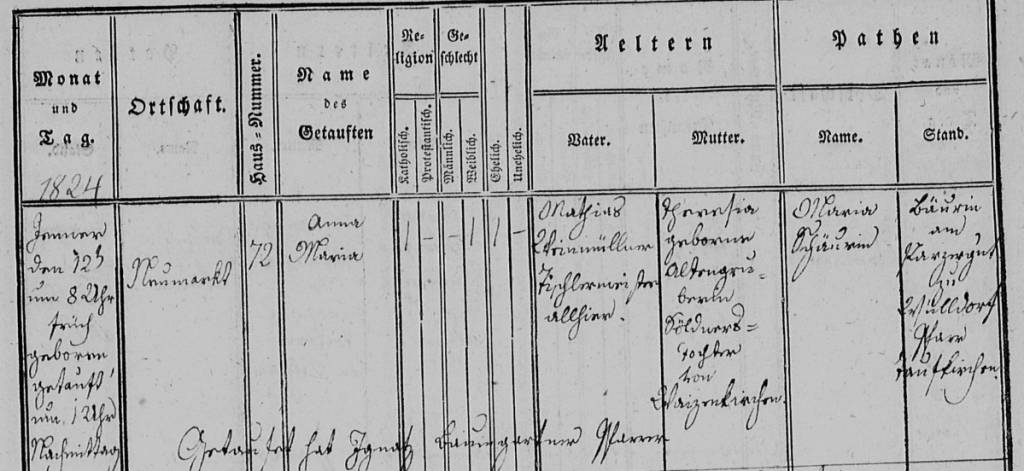German church records can be a genealogist’s dream. Filled with names, dates, places of residence and more, these entries can be the key to breaking down the brick walls in our genealogy research. If you don’t speak German, however, these records may seem a bit overwhelming. But never fear! Below, I’ve compiled the most important vocabulary words you’ll need to know when analyzing German church records – keep this list on hand, and you’ll be well on your way to filling in your family tree.
Important Church Record Vocabulary
| Name | Name, Namen, Nahme, Nahmen |
| Parish | Pfarre, Gemeinde |
| local | hiesig |
| Baptism | Taufe |
| Birth | Geburt |
| Child | Kind |
| Son | Sohn |
| Daughter | Tochter |
| Mother | Mutter |
| Father | Vater |
| Parents | Eltern, Aeltern |
| Boy | Knabe, Junge |
| Girl | Mädchen |
| Stillborn | totgeboren, todtgeboren |
| Year, Month and Day | Jahr, Monat und Tag |
| (In the) Morning; Afternoon; Evening | früh; nachmittags; abends |
| Legitimate; Illegitimate | ehelich; unehelich |
| Profession/Occupation | Stand, Beruf, Gewerbe |
| Godparents/Sponsors | Paten, Pathen, Taufpaten, Taufpathen, Gevatter |
| Witnesses | Zeugen, Beistand, Beystand, Beistände |
| Pastor/Priest; Assistant Pastor | Pfarrer, Priester; Koop., Coop. |
| Marriage | Trauung, Ehe |
| Groom | Bräutigam |
| Bride | Braut |
| Married | verheiratet, verehelicht |
| Wife | Frau, Ehefrau, Gattin, Weib, Eheweib |
| Husband | Mann, Ehemann, Gatte |
| Location/Place of Residence | Ort, Wohnort |
| Divorced | geschieden |
| Widower/Widow | Wittwer, Witwer; Wittwe, Witwe |
| Death | Tod |
| Die; Died | sterben; gestorben, starb |
| Burial/Funeral | Begräbnis, Beerdigung |
Author’s Note: For more church record vocabulary and tips on deciphering your church records, check out my newest book The Magic of German Church Records: Finding the Key to Your Ancestor’s Past.


2 Responses
This is great info, definitely will be a big asset when reading those Church Records, thank-you!
Great help! I have many old German birth and baptism church records scans from Mecklenberg-Schweren from 1830s to 1870s from LDS microfilms and the column after the parents’ names and child’s names is a column that contains three or four names. The heading seems to show “Names der Gevatteren.” For a female child they are all always females, and a male child they are all always male names. I can pick out from each of these people who themselves have multiple names, at least ONE of each name is contained in the child’s name. EX: for child named Maria Elisabeth Dorothea Kundt I see in next column Maria Wolter, Elisabeth Prom—–, and Dorothea Kundt. Each name is followed by very small writing, very long words, probably their occupation or status, followed by where they live, It seems like a female child had only female sponsors, and males had male sponsors, because these are the friends/relatives whose names were given to the child.